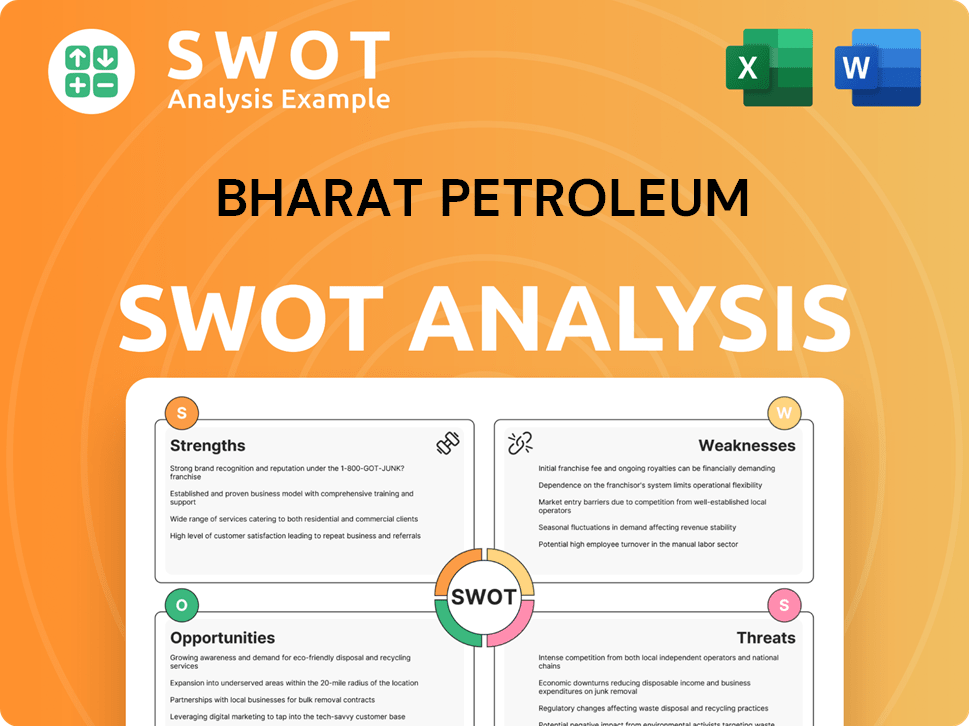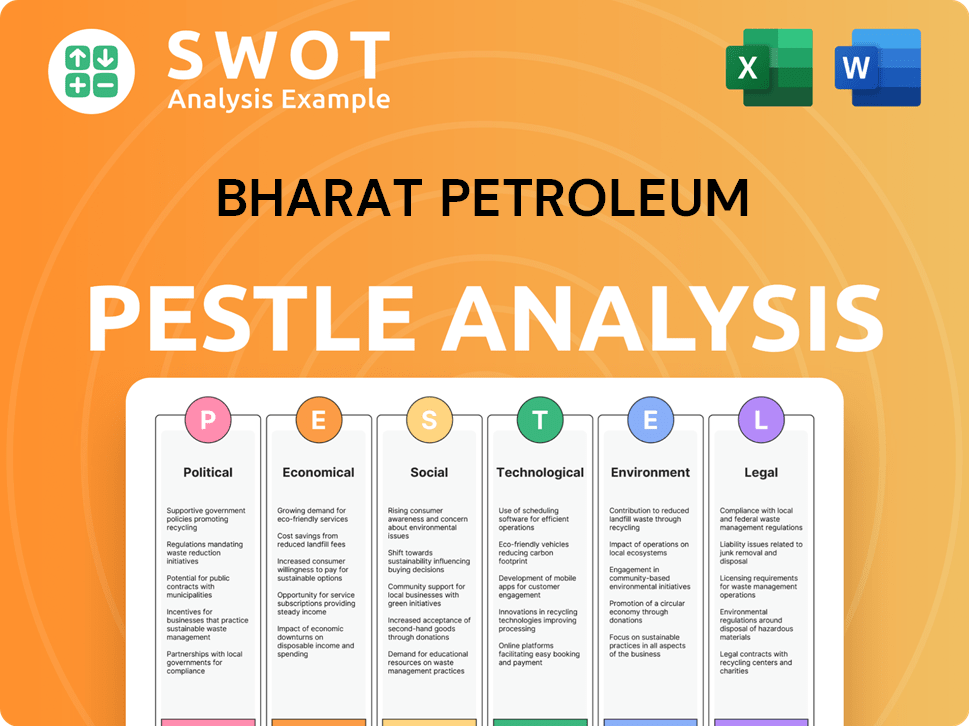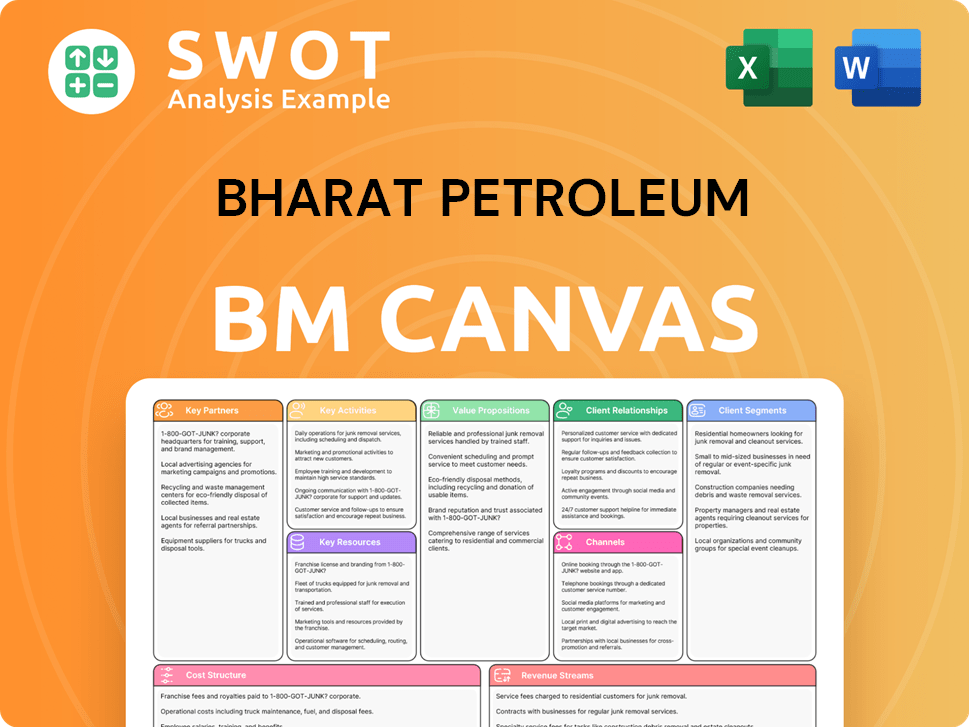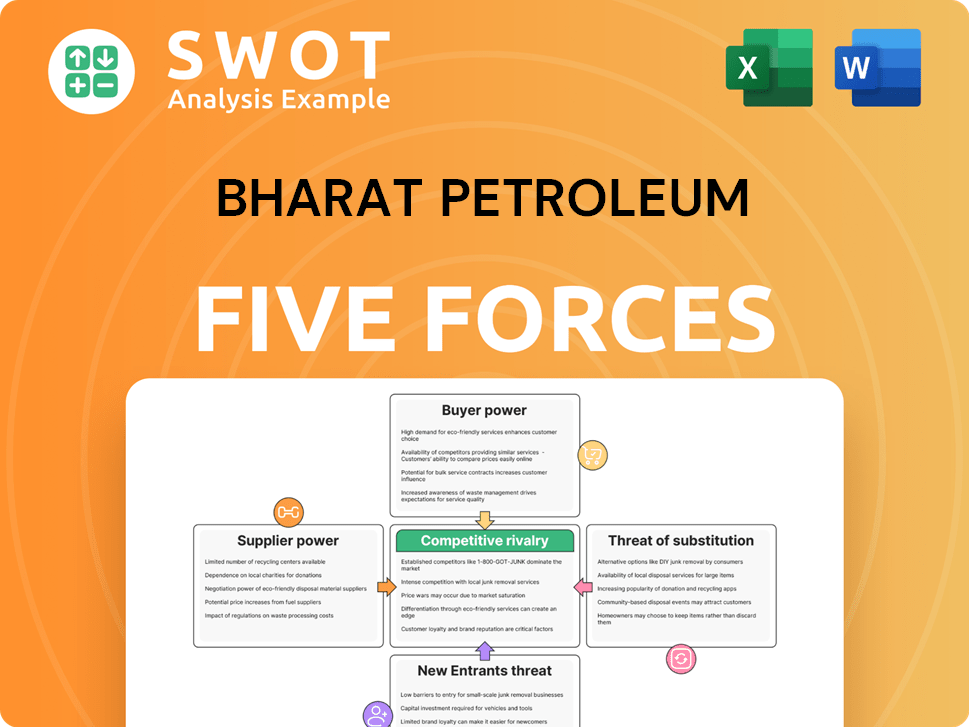Bharat Petroleum Bundle
Who Really Owns Bharat Petroleum?
The ownership structure of any company is the compass guiding its future, and for Bharat Petroleum Corporation Limited (BPCL), this is especially true. From its beginnings as Burmah-Shell Refineries Limited to its current status as a major player in India's energy sector, BPCL's ownership story is one of transformation and strategic significance. Understanding who controls BPCL is crucial for anyone looking to navigate the complexities of the Indian oil market.

As a Maharatna Public Sector Undertaking, the Government of India plays a significant role in BPCL's operations. This influence, combined with the company's market position, makes understanding the Bharat Petroleum SWOT Analysis and its ownership a critical endeavor. This exploration will delve into the evolution of BPCL ownership, including the Government stake in BPCL, and the implications for investors and stakeholders alike, answering questions like: Who is the current owner of Bharat Petroleum and is BPCL a government company?
Who Founded Bharat Petroleum?
The story of Bharat Petroleum Corporation Limited (BPCL) begins in 1952 as Burmah-Shell Refineries Limited, a joint venture. This marked the initial phase of what would become a significant Indian oil company. The formation laid the groundwork for the future, shaping the company's trajectory in the energy sector.
The early ownership of Burmah-Shell was primarily held by the Burmah Oil Company and Shell Petroleum Company. These entities, with their extensive experience in the oil and gas industry, were instrumental in establishing the company. The partnership between these international giants was key to the company's early operations.
The precise equity splits at the outset are not readily available in public records, but the collaboration between Burmah Oil and Shell was a defining feature. The joint venture was designed to meet India's growing energy requirements. This strategic move was crucial for the company's initial growth and expansion.
The initial focus of Burmah-Shell was on refining crude oil and distributing petroleum products throughout India. The vision of the founding entities was to capitalize on India's rising energy needs. Early agreements between Burmah Oil and Shell would have governed operational control and profit sharing.
- The early operations were focused on refining and distribution.
- The vision was to meet India's growing energy demands.
- Agreements governed operational control and profit sharing.
- The company aimed to establish a robust infrastructure for oil refining.
Bharat Petroleum SWOT Analysis
- Complete SWOT Breakdown
- Fully Customizable
- Editable in Excel & Word
- Professional Formatting
- Investor-Ready Format

How Has Bharat Petroleum’s Ownership Changed Over Time?
The most significant shift in the ownership of Bharat Petroleum (BPCL) occurred in 1976 when the Indian government nationalized Burmah-Shell Refineries Limited. This entity was then renamed Bharat Refineries Limited, and subsequently, in 1977, it became Bharat Petroleum Corporation Limited (BPCL). This transformation marked a pivotal moment, converting the company from a private joint venture into a Public Sector Undertaking (PSU), with the Government of India becoming the sole owner. This move dramatically altered the company's strategic direction, aligning it with national energy policies.
Since nationalization, the Government of India has maintained a dominant position in BPCL's ownership. As of March 31, 2024, the President of India, acting through the Ministry of Petroleum & Natural Gas, held approximately 52.98% of the total equity share capital of BPCL. This substantial stake gives the government considerable influence over the company's strategic decisions and governance. The evolution of BPCL ownership reflects the broader shifts in India's economic policies and the government's role in the energy sector.
| Ownership Type | Stakeholder | Approximate Stake (as of March 31, 2024) |
|---|---|---|
| Government | President of India (through Ministry of Petroleum & Natural Gas) | 52.98% |
| Public | Institutional and Non-Institutional Investors | 47.02% |
| Total | 100% |
Besides the Government of India, other significant stakeholders in BPCL include institutional investors, mutual funds, foreign portfolio investors (FPIs), and individual shareholders. The public holds a considerable portion of BPCL's shares, making it a publicly traded company on Indian stock exchanges. The public shareholding, including institutional and non-institutional investors, accounted for about 47.02% as of March 31, 2024. Major asset management firms, insurance companies, and pension funds typically hold shares. The government's majority ownership ensures that BPCL's strategic goals often align with national energy security objectives. Discussions regarding the potential privatization of BPCL have occurred in recent years, which could significantly change its ownership structure and strategic direction. Understanding the Competitors Landscape of Bharat Petroleum is also crucial for investors.
The Government of India is the major stakeholder in BPCL, holding about 52.98% of the shares as of March 31, 2024.
- BPCL was nationalized in 1976, transforming it into a PSU.
- Public shareholding accounts for approximately 47.02%.
- Institutional investors and mutual funds are significant shareholders.
- Potential privatization could alter the ownership structure.
Bharat Petroleum PESTLE Analysis
- Covers All 6 PESTLE Categories
- No Research Needed – Save Hours of Work
- Built by Experts, Trusted by Consultants
- Instant Download, Ready to Use
- 100% Editable, Fully Customizable

Who Sits on Bharat Petroleum’s Board?
The Board of Directors of Bharat Petroleum Corporation Limited (BPCL), a prominent Indian oil company, is pivotal in the company's governance. As of May 2025, the board typically includes a mix of government nominees, independent directors, and functional directors. The Chairman & Managing Director is usually a government appointee. Other directors represent key areas like finance, marketing, and refineries. This structure ensures a balance between government oversight and independent perspectives, which is crucial for the company's strategic direction.
The composition of the board reflects the BPCL ownership structure, with the Government of India holding a significant stake. This ownership structure influences the board's decision-making processes, ensuring that strategic decisions align with the government's objectives. The presence of independent directors also ensures that the company adheres to good corporate governance practices.
| Director Category | Description | Influence |
|---|---|---|
| Government Nominees | Appointed by the Government of India. | Significant influence on strategic decisions and policy. |
| Independent Directors | Non-executive directors providing oversight. | Ensure compliance and independent perspectives. |
| Functional Directors | Represent key operational areas. | Provide expertise in finance, marketing, etc. |
Given the Government of India's substantial ownership (approximately 52.98% as of March 31, 2024), its nominees on the board wield considerable voting power. The voting structure generally follows the one-share-one-vote principle for public shareholders. However, the government's majority stake translates into de facto control over major strategic decisions, board appointments, and policy directions. For more details on the company's background, you can read about the Brief History of Bharat Petroleum.
The Board of Directors at BPCL is a mix of government appointees, independent directors, and functional experts.
- The Government of India's majority stake gives it significant influence over strategic decisions.
- Independent directors provide oversight and ensure good corporate governance.
- The voting structure generally follows a one-share-one-vote principle, but the government's control is substantial.
- No significant proxy battles have reshaped decision-making due to stable government ownership.
Bharat Petroleum Business Model Canvas
- Complete 9-Block Business Model Canvas
- Effortlessly Communicate Your Business Strategy
- Investor-Ready BMC Format
- 100% Editable and Customizable
- Clear and Structured Layout

What Recent Changes Have Shaped Bharat Petroleum’s Ownership Landscape?
Over the past few years, Bharat Petroleum's (BPCL) ownership has been a focal point, primarily due to discussions around potential privatization. This represents the most significant trend influencing the company's ownership structure. As of early 2024, the Indian government was still considering options for strategic disinvestment, yet no definitive timeline or buyer had been finalized. This potential shift would fundamentally alter BPCL's status from a majority state-owned entity to one under private or wider public control. The Government of India currently holds a significant stake in BPCL, making it a key player in the Indian oil and gas sector.
Beyond the privatization discussions, BPCL has been undertaking strategic initiatives, including investments in refinery upgrades and expansion into renewable energy sources. These activities, while not directly changing ownership percentages, showcase the company's strategic direction under its present ownership structure. For instance, BPCL has announced substantial capital expenditure plans for the fiscal year 2024-25, with a focus on projects like the Bina refinery expansion and other infrastructure developments. The company's focus on energy transition and sustainability aligns with broader industry trends.
| Metric | Details | As of |
|---|---|---|
| Government Stake | Significant, with plans for potential disinvestment | Early 2024 |
| Capital Expenditure (FY2024-25) | Focused on refinery expansion and infrastructure | Announced |
| Strategic Direction | Emphasis on refinery upgrades and renewable energy | Current |
The ownership dynamics of BPCL, an Indian oil company, are largely shaped by the Government of India's stake. Major decisions regarding share buybacks or secondary offerings are typically made by the government and BPCL's board to optimize capital structure or facilitate divestment. Public statements from the company and government officials often highlight BPCL's strategic importance to India's energy security. Understanding the current ownership structure is crucial for anyone looking to understand the company's future direction and potential investment opportunities. The company is headquartered in Mumbai, India.
BPCL's ownership is primarily influenced by the Government of India's stake. Discussions around privatization have been ongoing, with potential implications for the company's future. The current shareholding pattern is a key factor in understanding BPCL's strategic decisions.
BPCL is investing in refinery upgrades and renewable energy projects. These initiatives reflect the company's strategic focus on modernization and sustainability. Capital expenditure plans for FY2024-25 include significant investments in infrastructure.
Broader trends include consolidation in the energy sector and a push for energy transition. These trends could influence future ownership dynamics. Any changes in ownership will be strategically decided.
The potential privatization of BPCL remains a key consideration. The government's decisions will significantly impact the company's future. Investors should monitor developments related to the Government stake in BPCL.
Bharat Petroleum Porter's Five Forces Analysis
- Covers All 5 Competitive Forces in Detail
- Structured for Consultants, Students, and Founders
- 100% Editable in Microsoft Word & Excel
- Instant Digital Download – Use Immediately
- Compatible with Mac & PC – Fully Unlocked

Related Blogs
- What are Mission Vision & Core Values of Bharat Petroleum Company?
- What is Competitive Landscape of Bharat Petroleum Company?
- What is Growth Strategy and Future Prospects of Bharat Petroleum Company?
- How Does Bharat Petroleum Company Work?
- What is Sales and Marketing Strategy of Bharat Petroleum Company?
- What is Brief History of Bharat Petroleum Company?
- What is Customer Demographics and Target Market of Bharat Petroleum Company?
Disclaimer
All information, articles, and product details provided on this website are for general informational and educational purposes only. We do not claim any ownership over, nor do we intend to infringe upon, any trademarks, copyrights, logos, brand names, or other intellectual property mentioned or depicted on this site. Such intellectual property remains the property of its respective owners, and any references here are made solely for identification or informational purposes, without implying any affiliation, endorsement, or partnership.
We make no representations or warranties, express or implied, regarding the accuracy, completeness, or suitability of any content or products presented. Nothing on this website should be construed as legal, tax, investment, financial, medical, or other professional advice. In addition, no part of this site—including articles or product references—constitutes a solicitation, recommendation, endorsement, advertisement, or offer to buy or sell any securities, franchises, or other financial instruments, particularly in jurisdictions where such activity would be unlawful.
All content is of a general nature and may not address the specific circumstances of any individual or entity. It is not a substitute for professional advice or services. Any actions you take based on the information provided here are strictly at your own risk. You accept full responsibility for any decisions or outcomes arising from your use of this website and agree to release us from any liability in connection with your use of, or reliance upon, the content or products found herein.